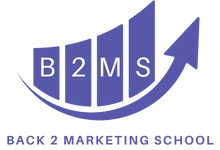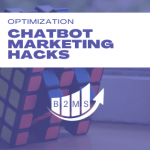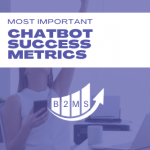How to evaluate your chatbot marketing?
The Chatbot Evaluation Guide
Chatbot marketing should be evaluated on the operational performance but also the overall investment/ROI. That means analyzing the chatbot engagement and conversion rates on the operational side, but also measuring the business outcome the chatbot generated.
Chatbot conversational marketing is rising in popularity. More and more websites adopt chatbots and live chat widgets. However, most set and forget the chatflows and even the medium altogether.
Chatbot marketing should double your websites’ conversion rate, but it could also harm it if the user is overwhelmed. Investments should be strictly evaluated on a regular basis to enhance the performance but also ensure that conversational marketing is the right channel for your and your website visitors.
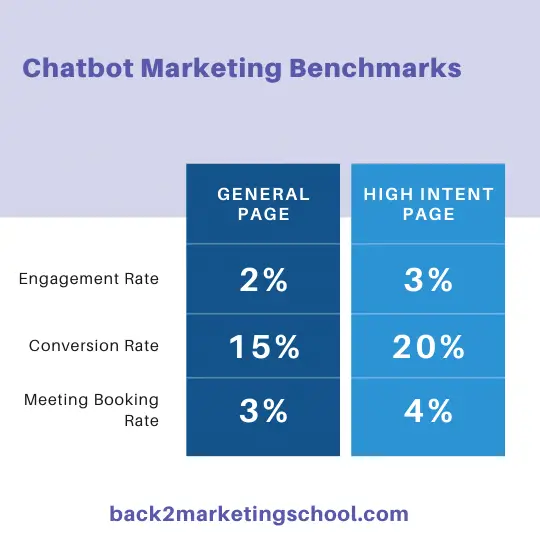
Evaluating chatbot operational performance
It is crucial to measure leading chatbot success metrics to optimize chatflows with chatbot marketing hacks. It’s important to not just focus on the overall numbers but rather break those down on multiple levels:
- Each chatbot/chatflow
- Lead source/channel: organic, Google ads, LinkedIn ads, etc.
- Page types: A campaign landing page vs static page on the website; page intent (homepage vs pricing); Call-to-action on the page (is there a form, a different action like sign-up, etc.?)
Evaluating chatbot lead quality
Lead generation is a key metric of every chatbot marketing. However, the lead quality may vary. Lead qualification is one of the main benefits of chatbots over static contact forms. Therefore, it’s crucial to monitor the lead quality for each chatbot flow. Different flows have different goals.
For instance, a bot on a solutions or services page may have the main goal to convert a potential lead into a demo call. However, it also gives the visitor the opportunity to register for a high-level webinar, download a consideration stage case study, or subscribe to the newsletter.
All four goals capture lead information but on different buyer stages. While this has obviously great advantages, it can also be that the majority of the leads are not qualified (yet).
While this ensures a great user experience, it may also have a negative spillover effect on the form submission of that page, which usually indicates a higher purchasing intent.
Evaluating website conversion rate
A chatbot aims to double a website’s conversion rate. You should measure your conversion rate for each page before implementing a chatbot. After implementing, you should re-run the numbers and see if the lead capture rate increased.
Sometimes it can be that fewer contact forms get submitted but the overall rate increases. Chatbot leads are usually not just added to existing contact numbers, but rather take away a part of those submissions. They indirectly impact the form submissions.
Here’s an example of what the conversions on a contact page could look like before and after a chatbot was implemented:
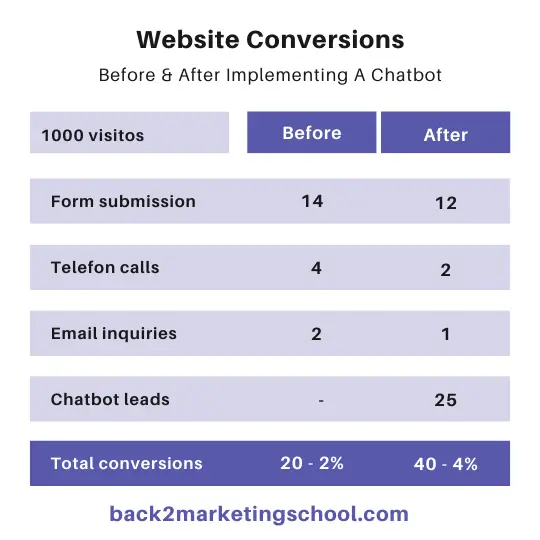
It’s likely to capture many leads through the chatbot, but it may take away from phone calls or form submissions. Also, as mentioned earlier, not every captured lead equals a sales qualified lead. Some of the additional leads may have only subscribed to the newsletter.
ROI of chatbot marketing
Put simply, you measure the revenue that was generated by the chatbot and compare it to the cost of the technology. Sometimes chatbots are built into the marketing automation software like HubSpot which makes this a little harder to assign a true cost of the chatbot.
You could also incorporate developing and managing time of your marketing staff to get a more accurate number.
It’s also common that the cost per lead decreases due to the higher amount of leads. You should report on different channels and mediums based on the stages of the buyer journey or deal stage. Therefore, your overall and campaign-based Return on Marketing Investments (ROMI) will increase as well.

Sascha is a Lifecycle Marketing Consultant with over 8 years of digital marketing experiences in Silicon Valley, the UK, and Germany.
After leading the demand generation for a 100+ million company, he decided to venture out on himself. He’s now helping clients to attract and convert more leads and customers.
His main focus are SEO, paid media & marketing automation – all with the focus to tie marketing campaigns to revenue.
Sascha has been featured in industry publications.
